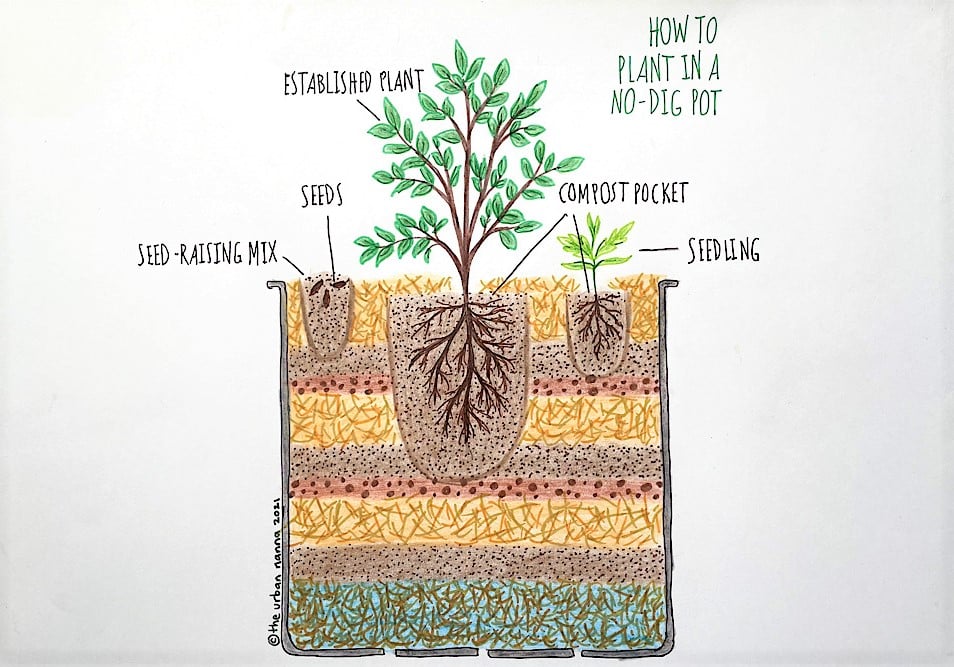

Growing food while living in a rental or small space often means using pots, but you don’t necessarily need to buy unsustainable plastic bags of potting mix. You can totally grow your own soil in pots too – and today, Anna Matilda from The Urban Nanna is going to show us how. Take it away, Anna…
I’ve lived in 7 different rental properties over the past decade, but I’ve been reluctant to let that stop me from growing some of my own food.
Shorter leases are unfortunately all-too-common in suburban areas of Australia, and as much as I’d love to, it’s not always practical – input:yield-wise – to convert lawn into growing spaces every time I move house.
So I’ve become a pot user (the gardening kind!) as a way of growing long-term crops that I can take with me each time moving day comes around.
Growing in pots means I can bring my apricot tree and asparagus with me, but there’s only merit in doing so if they’re going to perform well.
And we all know half the battle of helping plants succeed is ensuring they have strong, healthy soil to grow in.

The downside to commercial potting mix – and a permaculture alternative
Commercially sold potting mix and compost is a bit hit and miss. At best, it’s often just coloured chip-bark, sand, artificially added nutrients and wetting agents that will be used up or washed away within a year. At worst, it could be laced with herbicides that kill everything you plant.
Plus, good stuff is expensive, and it usually comes wrapped in plastic. No thanks.
To ensure it’s worth my time loading up trailers of potted plants each move, I build the soil in them to be as alive and rich as possible by using a diverse range of ingredients in no-dig layers. This includes everything from homemade compost to street tree leaves, toilet rolls to pet fur – if it can be converted into soil, I’ll use it in my no-dig layers.
By using what I have around me, not only do I Produce No Waste (permaculture principle 6), but I’m Creatively Using and Responding to Change ( permaculture principle 12) because the available ingredients around me change from rental to rental, and I constantly adapt my no-dig layers as a result.
And since we’re talking about permaculture principles, using up things around me that would normally be considered ‘waste’ is a great way to live Principle 8: Integrate Rather Than Segregate and Principle 11: Use Edges and Value the Marginal.

But first – what is no-dig gardening?
The basic idea of no-dig gardening is pretty self-explanatory: you don’t dig. Instead, you build layer upon layer of diverse organic ingredients that will gradually break down into rich, living soil.
You may know this as the ‘lasagne garden’ method and that’s because, in cross-section, a good no-dig bed looks a bit like a beautiful home-baked lasagne. And just like making lasagne, creating a good no-dig bed comes down to getting the proportion of layers right.
In a good no-dig bed, you’ll find a volume ratio of around 2:3 nitrogen to carbon. That means to every 2 parts of nitrogen-rich material in the bed, you’ll see 3 parts of carbon-rich material. Don’t worry – I’ll give you measurements a bit later, but for now just know this –
In its absolute essence, the recipe for a no-dig bed is: Create alternating layers of wet carbon-rich materials and nitrogen-rich materials, then plant in pockets of sifted, mature compost.
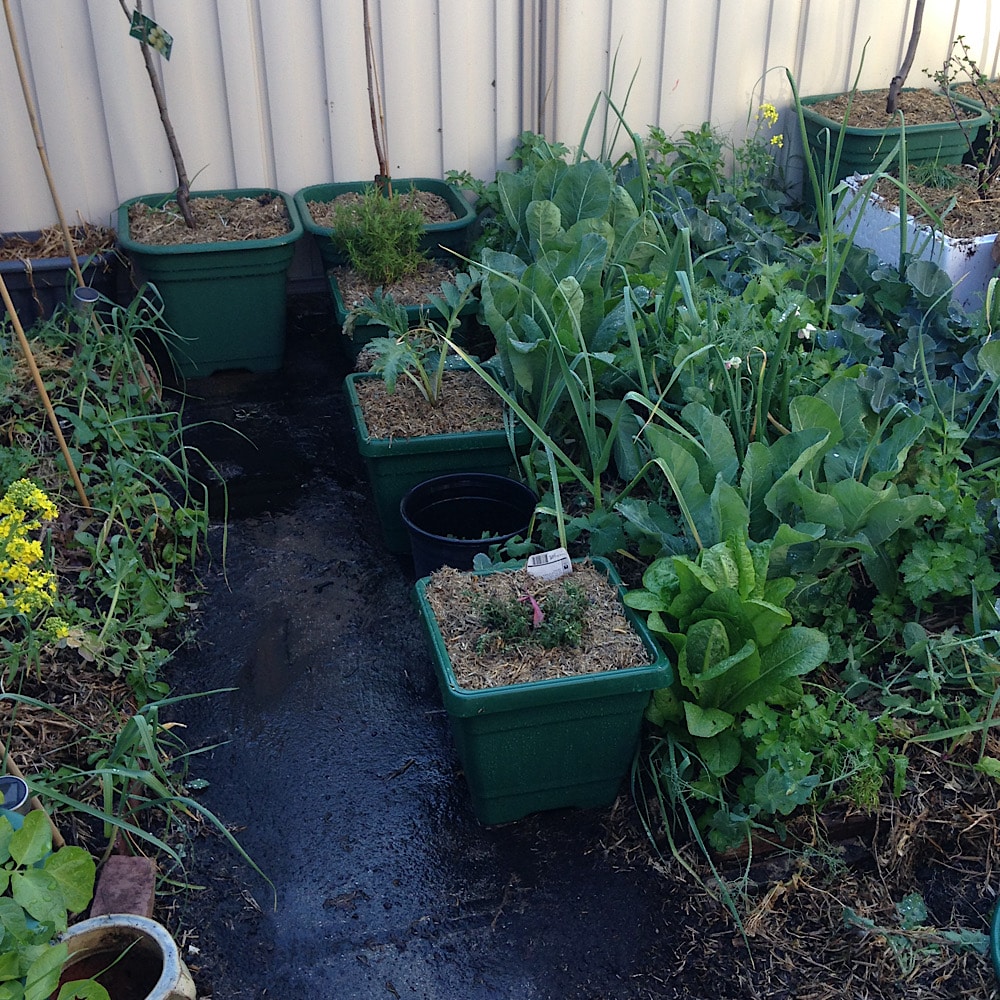
The no-dig gardening method can be applied to pots, too
So far we’ve looked at ‘no-dig beds’, and lots of what you’ll find online will be about using this method to build larger plots or raised garden beds. Which is great. But really, a pot is just a very small garden bed. So there’s no reason the same no-dig method can’t be used in growing containers of all sizes.
In fact, I’ve been doing just that for the past eight years – with great results.
I have fruit trees, long-term crops like asparagus and rhubarb, pollinator-attracting flowers, Australian natives, succulents – all happily growing in no-dig filled pots.
The only thing I don’t use no-dig layers for is my indoor plants, but I’m looking into ways the method could work there too.

A few key differences between no-dig beds and no-dig pots
As pots generally have adequate drainage, they don’t need the springy base layer of sticks and branches to provide aeration, as most recipes suggest for no-dig beds built on solid surfaces.
Equally, they don’t require a weed-suppressive mat of saturated cardboard or newspaper like no-dig beds built up on grass do.
The main problem for growing in pots compared to in large garden beds is the soil drying out. So the aim of the game when creating no-dig pots is to set them up with a really good reservoir of moisture at the bottom to start with, and to ensure that each layer is thoroughly saturated before the next is added.
It’s also helpful to tightly group pots together, hard up against each other, which reduces the surface area exposed to the elements.
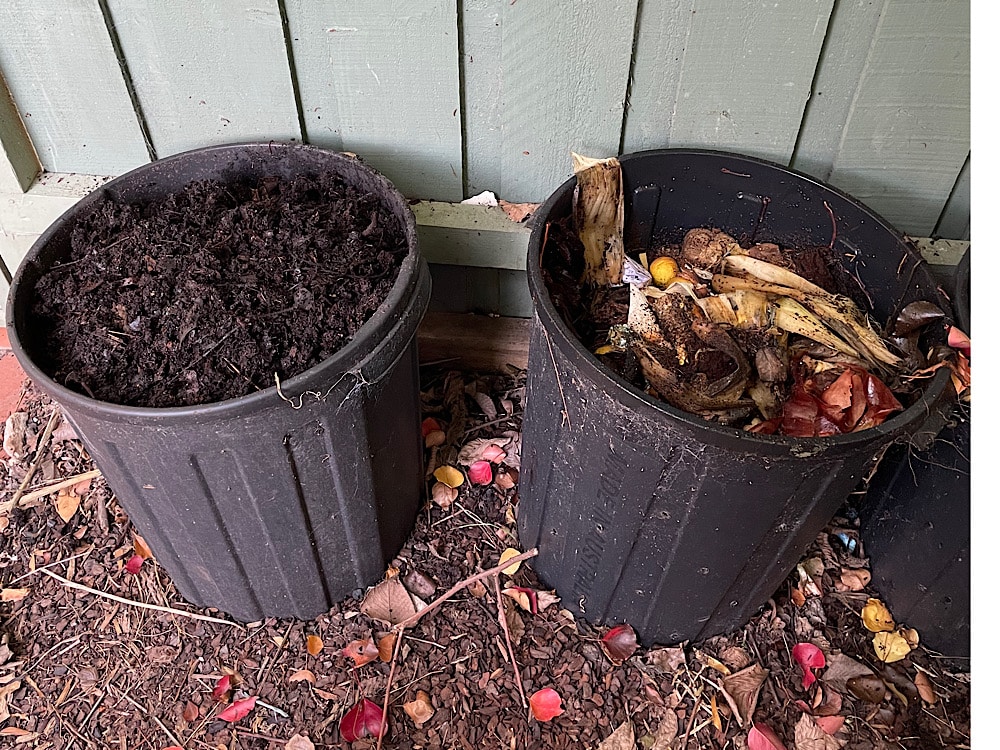
What ingredients to add to your layers in no-dig pots
To become confident at using no-dig layers, it’s helpful to understand what makes something carbon-rich or nitrogen-rich when building them.
So here’s list of some materials you can use for each. At my place, I tend to use pea straw, compost, worm castings and street tree leaves the most, with pea straw being the only ingredient I purchase.
Carbon-rich materials (sometimes called ‘brown’)
- Straw – pea straw is my preference
- Lucerne hay
- Dried leaves and small twigs
- Dried pine needles – but save these for acid-loving plants like blueberries
- Shredded paper – but no glossy mags or coated biscuit packets, as they’ve got nasties in dyes and varnishings that can lead to microplastic contamination
- Finely chopped hair – pet or human
- Dried out lawn clippings (not if you have super-weedy lawns though)
- Egg cartons minus their labels – tear into little bits
- Eggshells – oven-dry and blitz to a fine powder or they take forever to break down
- Vaccum-cleaner dust (only if you have natural-fibre floor coverings though, otherwise you’ll be adding microplastics from the synthetic carpet fibres to your soil)
Nitrogen-rich materials (sometimes called ‘green’)
- Compost
- Worm-castings
- Aged animal manure
- Kitchen scraps (go easy on these)
- Fresh lawn clippings (again, not if you’ve got weedy lawns)
- Fresh green leaves, shredded
- Tea leaves (remove from bags, as most contain microplastics)
- Coffee grounds
Once you’ve gathered a variety of these ingredients, you’re ready to fill your no-dig pots. Remember, you want 3 parts carbon-rich materials to every 2 parts of nitrogen-rich material: that’s one and a half times as much ‘brown’ as ‘green’.
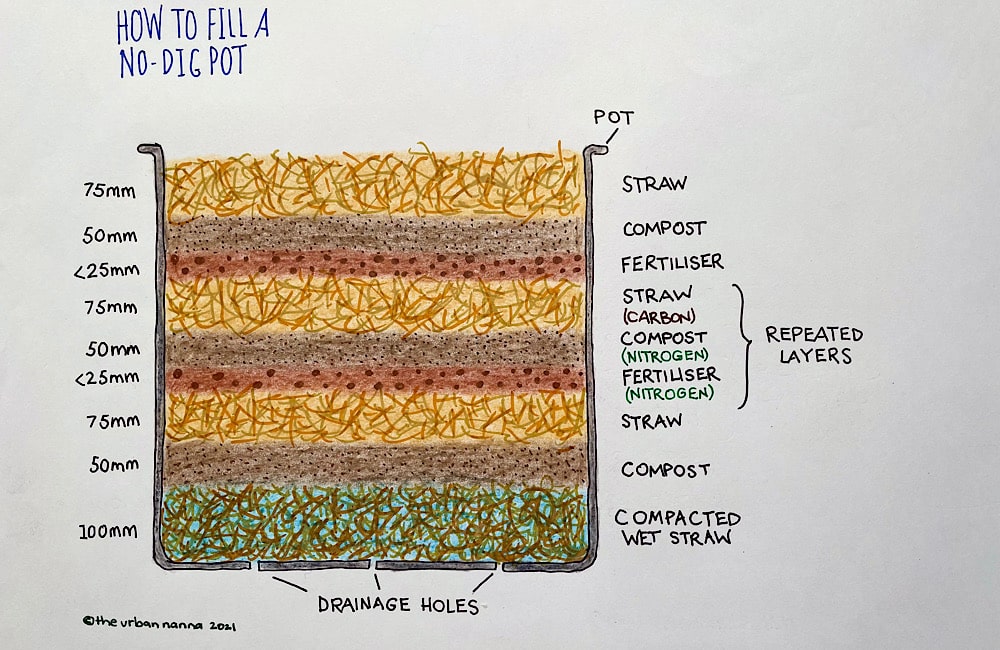
How to fill your no-dig pots – a step-by-step guide
Step 1: Gather your materials and pots.
Collect your nitrogen and carbon ingredients. Here, I’ve got well-rotted, sifted compost (nitrogen); pea straw and street tree leaves that I’d bagged up in autumn (carbon); worm castings (fertiliser); a pot rescued from hard-rubbish collection; and large polystyrene tub from the greengrocer, with drained holes cut in the bottom.
You will also need a pot, some hand tools (a sharp knife and something to scoops with), and some seed-raising mix and seeds.

Step 2. Create a water reservoir at the base of your pot.
I always start with a 100mm-150mm dense layer of thoroughly saturated pea straw. To make sure it’s wet through, mix the straw with water in a tub or bucket until every strand is wet – you can see it dripping as I squeeze a handful.
Then, compact the sodden straw into every corner of your pot by pushing down firmly with your fist. Note that this is the only layer I compact – I want the other layers to remain light and fluffy.
Step 3. Add a layer of compost (nitrogen).
Now it’s time to start layering your nitrogen and carbon, beginnng with nitrogen. I start with compost, but you can use anything from the list of possible ingredients above. I tend to add leaves, twigs and small branches and food scraps at the bottom end of the pot as they’ll take a bit longer to break down, and stick to compost and pea straw towards the top layers as they’re more gentle on tender new roots.
So, for this first layer – scoop compost over your compacted straw to form a 50mm layer. Water thoroughly until the layer is saturated all the way through.
Step 4. Add a layer of fluffy pea straw (carbon).
Sprinkle fluffy or chopped pea straw over, to form a 100mm layer.

Step 5. Add a scattering of fertiliser (worm castings or manure – nitrogen).
Scatter a sparse layer of fertiliser, no thicker than 25mm, over the previous carbon layer. Then water thoroughly until the carbon layer and fertiliser are thoroughly saturated.
I use worm castings from my worm farm, and a few stowaways usually come along for the ride. I’ve never had a problem with leaving them in.

Step 6: Repeat steps 3-5 until your pot is full. Finish on a straw (carbon) layer.
Make sure that each layer is thoroughly saturated. This helps the layers to break down into rich soil, and also prevents any of the layers becoming hydrophobic (water repellent).

Planting in your no-dig pots – yes, you can do this immediately
The beauty of using no-dig pots is that, just like potting mix, you can plant in them straight away. You just need a pocket of well-sifted compost or seed-raising mix (depending on what you’re planting) to put your plants or seeds into.
The idea is, you make a little pocket of super-friendly growing medium to plant into, and by the time the roots of your plant have reached the edges of that pocket, the ingredients of the no-dig layers will have begun to break down and provide suitable structure for good root growth.
I like to think of the compost/seed raising mix as a ‘cot’ that the plants live in while they’re young and fragile, and the no-dig layers as the ‘bed’ they graduate into.

To plant seedlings or established plants in no-dig pots
- Gently burrow out a hole in the no-dig layers. Make the hole twice as wide as the root-ball of your plant’s root ball, and 1.5 times as deep.
- Fill the bottom of the hole with finely sifted compost. This provides the base of your soil pocket (the ‘cot’).
- Place your plant in the hole.
- Backfill the hole with finely sifted compost. As with any planting, make sure there are no air-pockets around the roots, as this presents a barrier that roots can’t grow across and can stunt the growth of the plant.
- Gently press down, and re-cover with straw. Press the compost around the base of the plant (don’t push too hard as we want to maintain lightness throughout the no-dig layers for beneficial beasties to move around in), then re-cover the area with the straw you pushed aside.
- Water well.
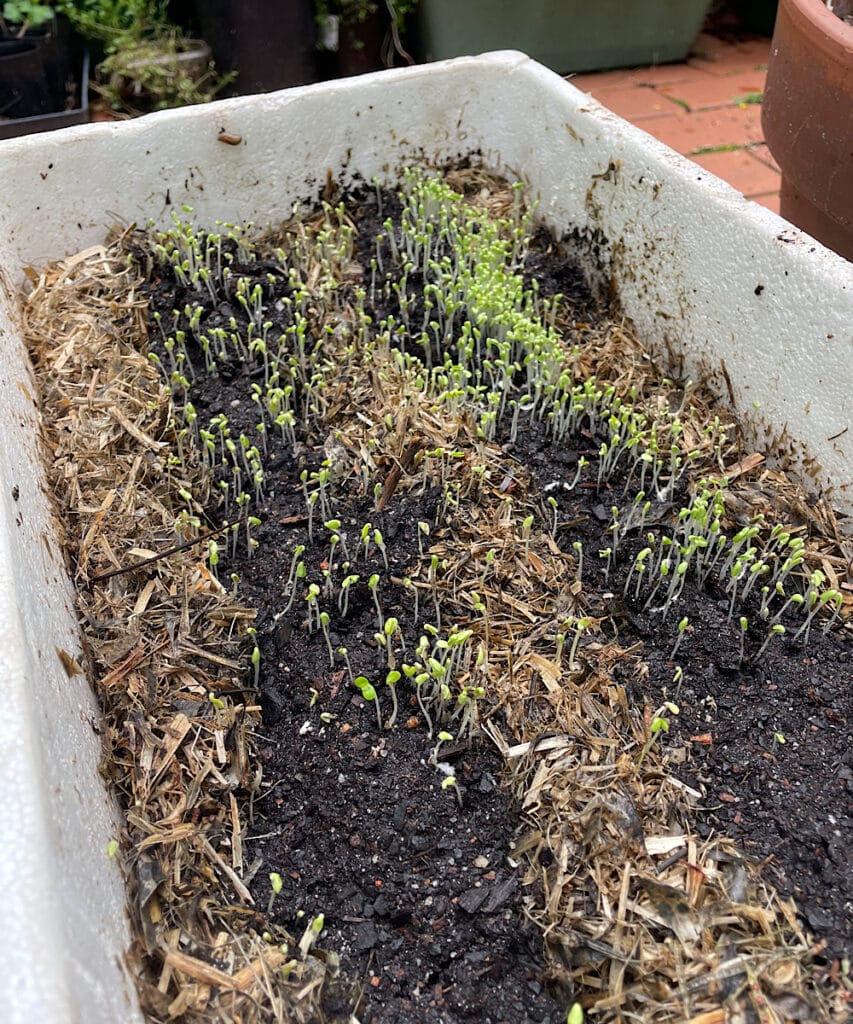
To plant seeds in no-dig pots
- Gently burrow out a hole or trench in the top layer of straw. The hole/trench should be about the width and depth of a fist. If I’m doing this for beans, peas or other larger seeds, I create a hole for each seed. If I’m thickly sowing green crops like lettuce, herbs, radish or leafy brassicas (like I am here), I create a trench.
- Fill the hole/trench with fine seed raising mix. This provides the bulk of your soil pocket (the ‘cot’).
- Sow your seeds as per growing instructions. For tiny seed, I simply scatter over the seed raising mix, then gently sprinkle a thin layer of mix on top.
- Water with a fine mist spray
- Optional extra – cover the seed bed for protection from pests and weather. A strip of hessian or a glass cloche works great.

How to keep feeding and maintaining your no-dig pots
As the organic layers in your no-dig pots begin to break down, the soil level in the pot will drop significantly. Don’t fret though: the simple solution is to just add as many repeated layers of Step 3-5 as needed to top it back up again.
A good rule of thumb is to add new layers every time you plant something new. If you’re only replacing a small plant in a big pot, just add new layers for the individual new plant.
Every autumn, I always give my pots a lovely deep mulching layer of street tree leaves, which means that unless I’m filling new pots, I really only need to buy pea straw once a year, as that’s enough to top-dress my 60-odd pots just fine.
So there you have it: growing in pots using no-dig methods. It’s quick, easy, and if you put a bit of thought into it, can be cheap as chips.

Resources
Articles and books
- No-Dig Gardening – crash course from Very Edible Gardens
- No-Dig Gardening – more details from Local Food Connect
- No Dig Organic Home & Garden – a book by Charles Dowding and Stephanie Hafferty. Charles’ website is also very informative.
- Composting Guide Book – by Goodlife Permaculture
- A beginner’s guide to worm farms – our full guide
- Making seaweed fertiliser – our how-to
Websites and hashtags
- Compostable Kate has your answers around compost.
- Share Waste – matches scraps with composters around the world.
- If you’re an Instagram user, you can explore content and meet like-minded gardeners by using hashtags #NoDigGardening, #RentalPermaculture and #PermacultureRenting, and pick up other handy hints for potted rental gardens with #SmallSpaceGardening.
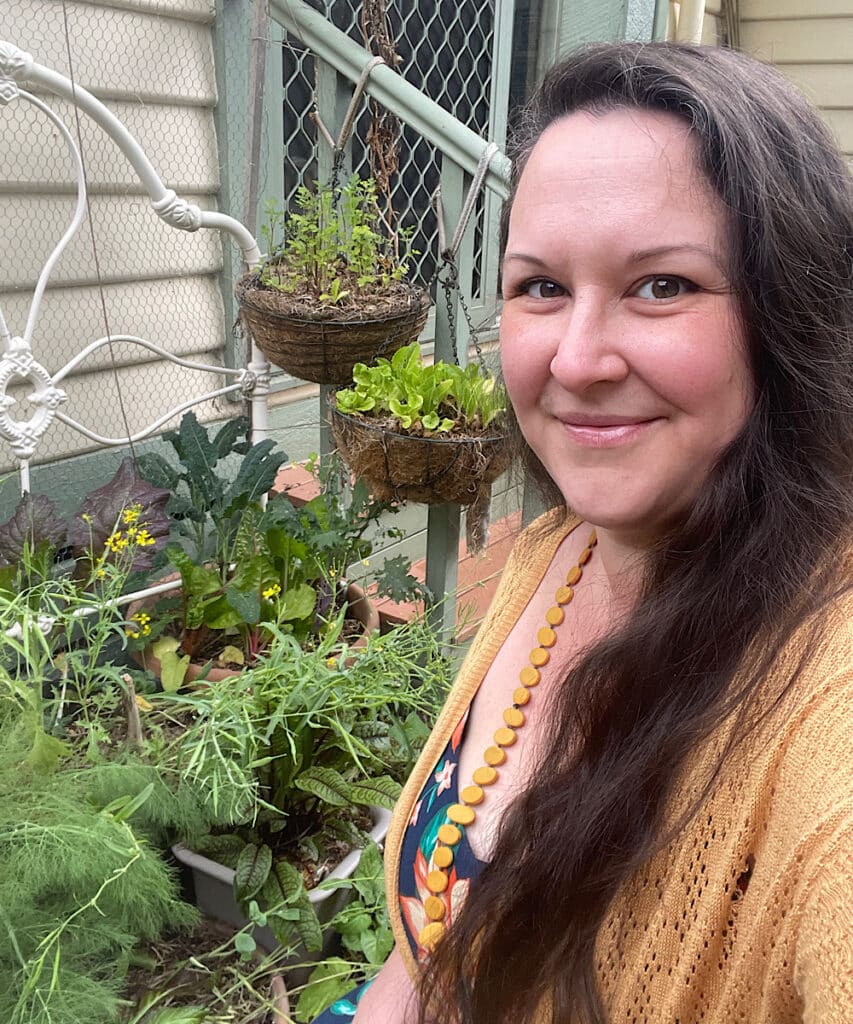
About the author: Firmly steeped in permaculture ethos, Anna Matilda – aka The Urban Nanna – showcases and teaches traditional skills, crafts and methods of sustainable living. All while renting! Find out more via the The Urban Nanna website.













Just finished Matthew Evans’ ‘Soil’.
Likely to be a renter in the near future and was wondering how I can growing in pots ‘properly’.
Here’s my answer! While I know about no-dig beds, I never made the connection to scale about doing it in pots! Thank you.
you’re welcome – good book, hey?
Great information. I have been working on my No Dig garden for some time now and have lots of pots that I use for my pepper plants. I generally buy soil but this information will be very useful for next spring when I use my pots again. Thanks so much!
no worries!
This soun slike a neat idea. I do garden in raised beds and pots now. I will give this a try in 2022. Thanks.
let us know how you go Marvin?
What a fabulous idea , I have added this to my reading list.
Thank you so very much
This is a great idea. We use this principle for our larger garden beds in the veggie garden, but this has given me inspiration to try no-dig pots as well. Thanks.
Hi Kirsten, this is great info thank you. My question is – if I’m to plant perennial herbs (thyme, sage etc) and citrus into pots using this method (ie. not annuals), given the significant drop in soil level as the materials break down – do you think it’s a suitable method for those permanent types of plants? do you have any experience growing those types of plants with this method?
Hey Amy, i think it would be fine – you might need to add some more material over time to pump up the overall biomass? But great for herbs 🙂
Thanks Kirsten. Yes I’m thinking if I added the material like a donut around the edges when the pot needs topping up, staying clear of the trunk/stem of the plant, it would work.
I have been employing this method with all my pot plants since reading this article and learning more about soil and no dig method gardening and I will never go back! I have even brought a juvenile potted lemon tree back from the brink of dead using this method! It make so much sense!
This was such a good idea for filling some larger pots for dwarf fruit trees – but I am a bit bamboozled as to how to address the rather dramatic drop in pot content, as the plant pocket has dropped with the filling content over the last 9 months despite adding new layers occasionally? Gently dig wider than the root ball, lift out the tree, top up the pot and replant?
Heya Sarah – you could just layer more material on top, in the same type of layers?
I have been a no-dig gardener for a long,long time. Old age (86) impediments forced me to move to a potted garden last year, with disastrous results. I used store bought soil and soil improvers. Decided to give it all away. Your method has given me new hope. I’ll try again. The inspiration for my no-dig gardening was the book by John Jeaves “How to Grow More Vegetables”.
Very motivational read! I don’t have access to pea straw. Would sugar cane mulch suffice, or would you recommend an alternative please?
yep sugar cane mulch is a great choice –